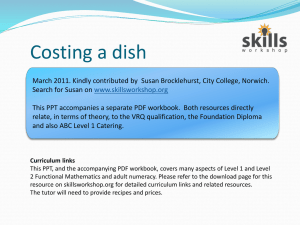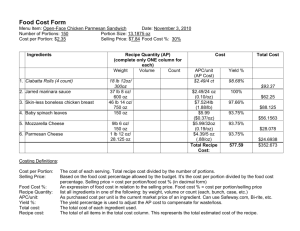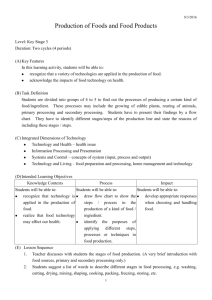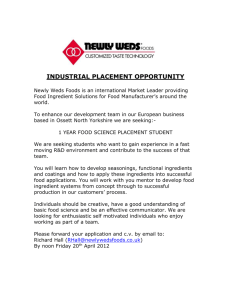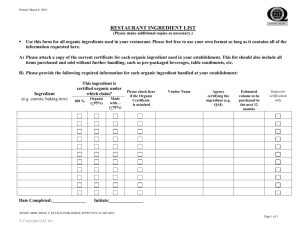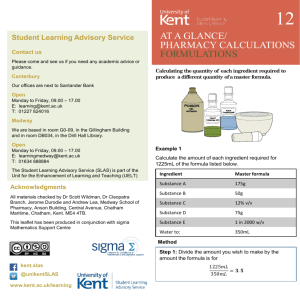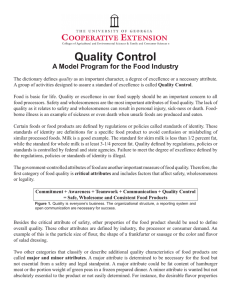My Recipe for Leadership
advertisement
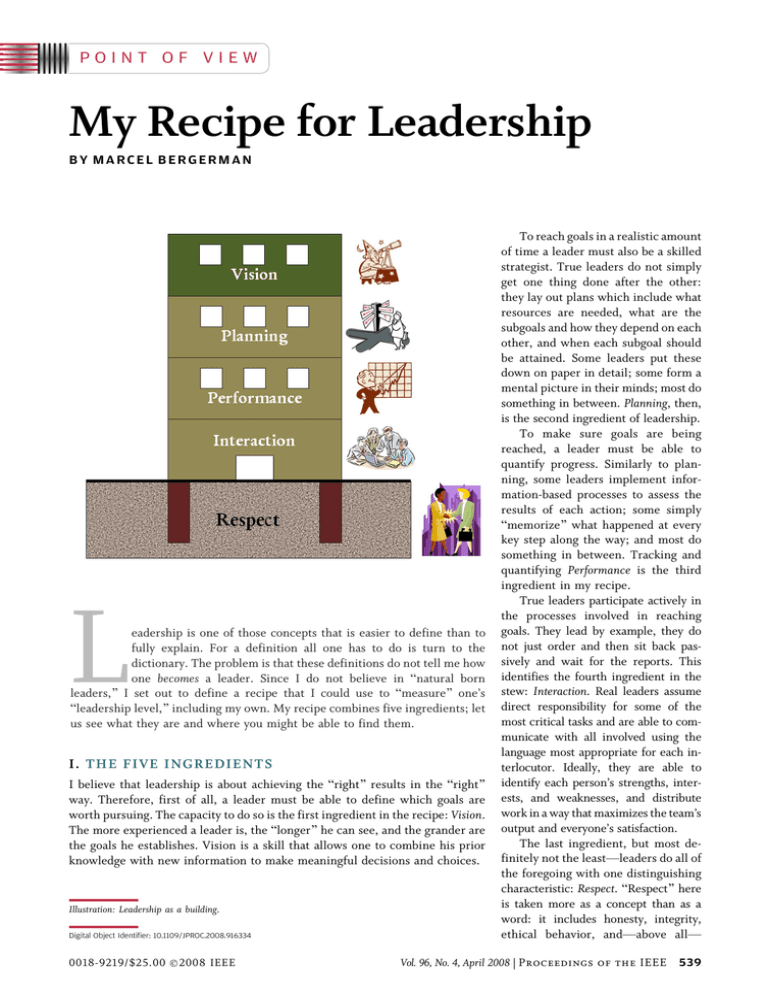
POINT OF VIEW My Recipe for Leadership BY MARCEL BERGERMAN L eadership is one of those concepts that is easier to define than to fully explain. For a definition all one has to do is turn to the dictionary. The problem is that these definitions do not tell me how one becomes a leader. Since I do not believe in Bnatural born leaders,[ I set out to define a recipe that I could use to Bmeasure[ one’s Bleadership level,[ including my own. My recipe combines five ingredients; let us see what they are and where you might be able to find them. I. THE FIVE INGRE DIENTS I believe that leadership is about achieving the Bright[ results in the Bright[ way. Therefore, first of all, a leader must be able to define which goals are worth pursuing. The capacity to do so is the first ingredient in the recipe: Vision. The more experienced a leader is, the Blonger[ he can see, and the grander are the goals he establishes. Vision is a skill that allows one to combine his prior knowledge with new information to make meaningful decisions and choices. Illustration: Leadership as a building. Digital Object Identifier: 10.1109/JPROC.2008.916334 0018-9219/$25.00 Ó 2008 IEEE To reach goals in a realistic amount of time a leader must also be a skilled strategist. True leaders do not simply get one thing done after the other: they lay out plans which include what resources are needed, what are the subgoals and how they depend on each other, and when each subgoal should be attained. Some leaders put these down on paper in detail; some form a mental picture in their minds; most do something in between. Planning, then, is the second ingredient of leadership. To make sure goals are being reached, a leader must be able to quantify progress. Similarly to planning, some leaders implement information-based processes to assess the results of each action; some simply Bmemorize[ what happened at every key step along the way; and most do something in between. Tracking and quantifying Performance is the third ingredient in my recipe. True leaders participate actively in the processes involved in reaching goals. They lead by example, they do not just order and then sit back passively and wait for the reports. This identifies the fourth ingredient in the stew: Interaction. Real leaders assume direct responsibility for some of the most critical tasks and are able to communicate with all involved using the language most appropriate for each interlocutor. Ideally, they are able to identify each person’s strengths, interests, and weaknesses, and distribute work in a way that maximizes the team’s output and everyone’s satisfaction. The last ingredient, but most definitely not the leastVleaders do all of the foregoing with one distinguishing characteristic: Respect. BRespect[ here is taken more as a concept than as a word: it includes honesty, integrity, ethical behavior, andVabove allV Vol. 96, No. 4, April 2008 | Proceedings of the IEEE 539 Point of View humility. A respectful leader embodies the adage BWith great power comes great responsibility.[ Leaders understand the greatest power they possess: that of motivating people to work on the goals that they deem important, and do not abuse or misuse it. Here, again, leading by example is what separates leaders from nonleaders: leaders do not scold employees in front of other people; do not blame people irresponsibly; do not claim credit for other people’s work; and do not cheat on their spouses and do not beat their kids. I like to visualize leadership as a building (Fig. 1). Planning, Performance, and Interaction are the base floors. Vision is the penthouseVit allows the leader to Bsee[ beyond the Bclouds[ that obstruct most people’s capability to focus on the tasks and goals rather than on the hurdles on the way. And what about Respect? Respect is the building’s foundation. And just like in actual constructions, the deeper and more solid the foundation, the taller one can build. In other words, the more respectful, honest, responsible, ethical, and humble a person is, the further she can go as a leader and the greater is her potential impact on a society. That Respect is a foundation for all other aspects of leadership is much more than a metaphor. Leaders are ambitious but not greedy; and as my friend Dante Mantovani once taught me, the fine line that divides ambition from greed is called ethics. RespectV or its ethics componentVis what restrains true leaders from running astray, working to maximize their own profit or benefit to the detriment of everybody else on the team. Likewise, leaders are visionary but not megalomaniacs; again, the fine line that divides these two qualities is humility, a component of Respect. II. SO WHERE DO I GET THE I NGRE DIE NTS ? The base Bfloors,[ Planning, Performance, and Interaction, can be formally learned in courses and through 540 coaching or mentoring. Most people can overcome their handicaps in these areas by dedicating themselves wholeheartedly to studying and practicing appropriate processes and methods. What about Vision? I see at least two ways one can work out to become a visionary, both demanding time and hard work. The first is through a mentor-apprentice relationship, where you tag along with a visionary and get him to teach you how to do it (which raises the question of where the first visionary came from; I simply assume that this skill evolved with humans since the dawn of civilization). This is the most straightforward way. The second, less easy, but for some equally effective, is to learn by trial and error. These two methods to develop Vision are akin to the way our society has formed graduate level researchers for centuries. Note that Vision and experience are intimately related: while a great deal of the latter does not imply the former, the former definitely does not exist without the latter. Vision is also a moving target. As the leader’s envisioned goals get closer and closer to being accomplished, he is already thinking of what to pursue next. That brings us to Respect. This is the one ingredient leaders bring with themselves from home as they enter the workforce. Honesty, ethics, and humility cannot be learned in courses, or through coaching or mentoring, or by observation from a master. Respect is imbued in a leader during his infancy and childhood. While it is clear that some people are able to change if they so wish (e.g., some criminals do regenerate), I have never met a disrespectful person who diligently worked on changing his ways. A person’s personality of contempt and greed at 20 years old will be the same at 50. I know this is a self-fulfilling prophecy, but it is based on my own experience with people. Respect is, therefore, the most exquisite ingredient in the recipe, and the reason why I compare it to the building’s foundation: without Respect, a person may fool many into thinking he is a leader for a while, but eventually his Bbuilding[ will col- Proceedings of the IEEE | Vol. 96, No. 4, April 2008 lapse. The end result, as you can imagine, can be devastating to all involved. III . M IS SI N G AN INGREDIENT? One might ask why technical expertise is not listed as an ingredient for leadership. That is because technical expertise and leadership run in parallel with each other. A true leader may or may not be wholly proficient in the technical aspects of the tasks to be executed. This is where she demonstrates her right to the title: she is humble enough to admit partial ignorance in many subjects and surrounds herself with the best and brightest in those subjects, thus effectively covering all aspects of the work to be pursued. IV. TO CONCLUDE If you think of a Bleadership city,[ you can imagine a varied collection of buildings: some short with deep foundations (a beginning leader with the potential to grow tremendously); some very tall with deep foundations (Bfull[ leaders who achieved their maximum potential); and some tall with shallow foundations (pseudo-leaders who will eventually be caught red-handed); and many other possible variations. A Bleadership city[ is, of course, dynamic. You look at it today, and then five years from now, and you will see that some buildings added more height to their base floors and some added more height to their penthouseVbut you will not see any building in which the foundation grew deeper. The Respect you start with determines how much Vision, Planning, Performance, and Interaction you can put on top. Leaders make themselves; they are not born that way. If you believe you have the foundation necessary to become one, work on it. Our societies would fare a lot better with true leaders guiding and conducting them. h Acknowledgment The author wishes to thank R. Jasinschi, G. Podnar, J. Jaime da Cruz, J. Dolan, and R. Lucky for their comments on drafts of this paper.
